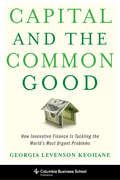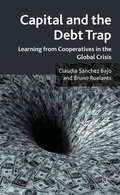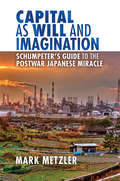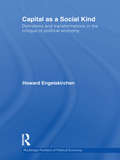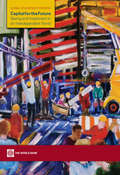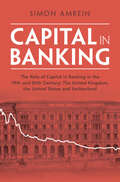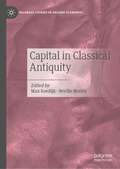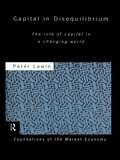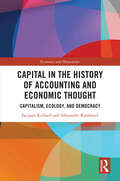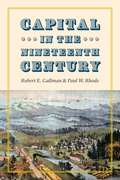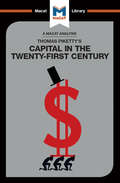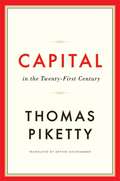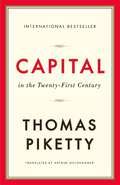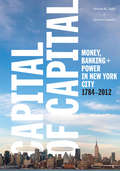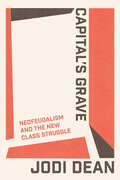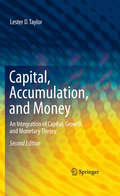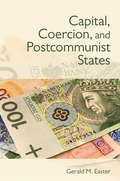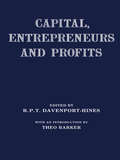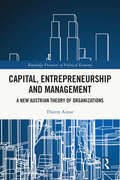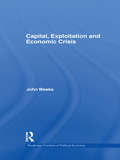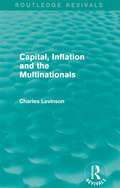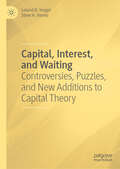- Table View
- List View
Capital and the Common Good: How Innovative Finance Is Tackling the World's Most Urgent Problems (Columbia Business School Publishing)
by Georgia Levenson KeohaneDespite social and economic advances around the world, poverty and disease persist, exacerbated by the mounting challenges of climate change, natural disasters, political conflict, mass migration, and economic inequality. While governments commit to addressing these challenges, traditional public and philanthropic dollars are not enough. Here, innovative finance has shown a way forward: by borrowing techniques from the world of finance, we can raise capital for social investments today. Innovative finance has provided polio vaccines to children in the DRC, crop insurance to farmers in India, pay-as-you-go solar electricity to Kenyans, and affordable housing and transportation to New Yorkers. It has helped governmental, commercial, and philanthropic resources meet the needs of the poor and underserved and build a more sustainable and inclusive prosperity. Capital and the Common Good shows how market failure in one context can be solved with market solutions from another: an expert in securitization bundles future development aid into bonds to pay for vaccines today; an entrepreneur turns a mobile phone into an array of financial services for the unbanked; and policy makers adapt pay-for-success models from the world of infrastructure to human services like early childhood education, maternal health, and job training. Revisiting the successes and missteps of these efforts, Georgia Levenson Keohane argues that innovative finance is as much about incentives and sound decision-making as it is about money. When it works, innovative finance gives us the tools, motivation, and security to invest in our shared future.
Capital as Will and Imagination: Schumpeter’s Guide to the Postwar Japanese Miracle
by Mark MetzlerWith this book, Mark Metzler continues his investigation into the economic history of twentieth-century Japan that he began in Lever of Empire. In Capital as Will and Imagination, he focuses on the successful stabilization of Japanese capitalism after the Second World War. How did a defeated and heavily damaged nation manage reconstruction so rapidly? What economic beliefs resulted in the "miracle" years of high-speed economic growth? Metzler argues that the inflationary creation of credit was key to Japan's postwar success-and its eventual demise due to its instability over the long term.To prove his case, Metzler explores heterodox ideas about economic life , in particular Joseph Schumpeter's realization that inflation is intrinsic to capitalist development. Schumpeter's ideas, widely ignored within standard American neoclassical economic theory, were shaped by his experience of Austria's reconstruction after 1918. They were highly influential in Japan, and Metzler traces their impact in the period from the Allied Occupation, starting in 1945, through the Income Doubling Plan of 1960. Japan after defeat, Metzler argues, illustrates the critical importance of inflationary credit creation for increased production.
Capital as a Social Kind: Definitions and Transformations in the Critique of Political Economy (Routledge Frontiers Of Political Economy Ser. #141)
by Howard EngelskirchenCapital as a Social Kind provides an introduction to social kinds in social theory. Thinking about kinds, the way we sort the things of the world into categories -- water, for example, is a natural kind – has made an important contribution to our understanding of science in the last half century, but these advances have been largely applicable to the natural, rather than the social sciences. Drawing on the rich examples offered by Marx’s analysis of capital and exploring a methodology that will be of interest to both Marxist and non-Marxist social theorists alike, Capital as a Social Kind extends this approach to the study of social life. The book argues that, provoked by his study of Aristotle, Marx’s attentions foreshadowed contemporary themes in the realist philosophy of science. Importantly, social kind analysis is relevant not only to understanding his critique of political economy but illuminates also a materialist study of law, justice, morality and the transition to socialism. Social kind analysis also opens a path for the development of today’s moral realism by suggesting the need for a systematic study of the causal structures of social life. In this respect the importance of normative themes in Marxism is defended against claims that the Marxist tradition lacks the resources to call capitalism unjust or to defend morality and human rights. The origin of capital, Marx suggests, can be found in the rupture of an original unity between the laborer and the means of labor, and the book explores the way a structure of separations best characterizes capital as a social kind. This uncovers a little developed emphasis in Marx’s work – his focus on the phenomena of separation that define our lives and also on forms of association required to transcend them. Given that capitalism has made the instruments of labor instruments of social labor, forms of association that would recover worker control over them must be democratic. The transition to socialism, the book concludes, is just winning the battle of democracy. This book will be of interest to students and researchers of economics, philosophy and indeed any social science subject.
Capital de vida: Legado de valores en la cultura empresarial y familiar
by Alejandro Curcio¿Cuál es el valor del dinero? ¿Dónde está el éxito? ¿Cómo se enfrenta una crisis? ¿Es posible la coherencia entre la vida empresarial y la vida personal? ¿Dónde radica nuestro verdadero capital de vida? Todos tenemos un proyecto que construimos día a día, en el ámbito empresarial y también en el familiar. Soñamos con él, transpiramos por él, siempre jugando de titular. Pero ¿qué sucederá cuando ya no ocupemos ese lugar? Alejandro Curcio, director de AYAX, empresa que representa a la marca Toyota en Uruguay, debió asumir prematuramente la conducción de la empresa familiar y vivió en carne propia la necesidad de dejar asentados los trazos principales de la cultura empresarial y en definitiva el conjunto de valores que defendemos a lo largo de la vida y transmitiremos a los que vendrán. La construcción de un legado de valores conlleva introspección y preguntas incómodas que el autor vuelca en este libro como pocas veces lo hacen los líderes empresariales. Dice Hugo Burel en el prólogo: # Si uno conoce a Alejandro, al leer su libro puede comprender que la profusión de reflexiones y conceptos, el salto desprejuiciado de un tema al otro y el fervor en la defensa de las convicciones, mostradas sin falso pudor ni filtro, forman parte de su personalidad extrovertida y su búsqueda permanente de una mejora continua en todas las dimensiones de la existencia. Este libro es el reflejo que se anima a indagar en si mismo y a dialogar con el lector con absoluta sinceridad #
Capital for the Future: Saving and Investment in an Interdependent World
by the editors at The World BankThe gradual acceleration of growth in developing countries is a defining feature of the past two decades. This acceleration came with major shifts in patterns of investment, saving, and capital flows. This second volume in the Global Development Horizons series analyzes these shifts and explores how they may evolve through 2030. Average domestic saving in developing countries stood at 34 percent of their GDP in 2010, up from 24 percent in 1990, while their investment was around 33 percent of their GDP in 2012, up from 26 percent. These trends in saving and investment, along with higher growth rates in developing countries, have resulted in developing countries’ share of global savings now standing at 46 percent, nearly double the level of the 1990s. The presence of developing countries on the global stage will continue to expand over the next two decades. Analysis in this report projects that by 2030, China will account for 30 percent of global investment activity, far and away the largest share of any single country, while India and Brazil (at 7 percent and 3 percent) will account for shares comparable to those of the United States and Japan (11 percent and 5 percent). The complex interaction among aging, growth, and financial deepening can be expected to result in a world where developing countries will contribute 62 of every 100 dollars of world saving in 2030, up from 45 dollars in 2010, and where they account for between $6.2 trillion and $13 trillion of global gross capital flows, rising from $1.3 trillion in 2010. Trends in investment, saving, and capital flows through 2030 will affect economic conditions from the household level to the global macroeconomic level, with implications not only for national policy makers but also for international institutions and policy coordination. Policymakers preparing for this change will benefit from a better understanding of the unfolding dynamics of global capital and wealth in the future. This book is accompanied by a website, http://www.worldbank.org/CapitalForTheFuture, that includes a host of related electronic resources: data sets underlying the two main scenarios presented in the report, background papers, technical appendixes, interactive widgets with variations to some of the assumptions used in the projections, and related audio and video resources.
Capital in Banking: The Role of Capital in Banking in the 19th and 20th Century: The United Kingdom, the United States and Switzerland (Studies in Macroeconomic History)
by Simon AmreinCapital in Banking traces the role of capital in US, British, and Swiss banking from the 19th to the 21st century. The book discusses the impact of perceptions and conventions on capital ratios in the 19th century, the effects of the First and Second World Wars, and the interaction of crises and banking regulation during the 1930s and the 1970s. Moreover, it emphasises the origins of the risk-weighted assets approach for measuring capital adequacy and explains how the 2007/2008 crisis led to a renaissance of unweighted capital ratios. The book shows that undisclosed reserves, shareholders' liability, and hybrid forms of capital must be considered when assessing capital adequacy. As the first long-run historical assessment of the topic, this book represents a reference point for publications in economics, finance, financial regulation, and financial history. This title is also available as Open Access on Cambridge Core.
Capital in Classical Antiquity (Palgrave Studies in Ancient Economies)
by Neville Morley Max KoedijkThis book discusses the extent to which Thomas Piketty’s work can offer a model for ancient economic history, both methodologically and politically. The book derives from a research workshop in Berlin in April 2018, which brought together a group of established and early career scholars to discuss the implications of Piketty’s work and related themes for classical antiquity. Key questions reflected in the text include:d: How should we characterise the ‘development’ of the economy/economies of the classical Mediterranean, in relation to the role of ‘capital’ and the prevalence of inequality? How was wealth, both public and private, evaluated and managed? How much of the wealth of their society did the ancient 1% control – and is their dominance better understood in terms of the power of capital, or the role of predation and state capture? How far did certain ancient polities – above all the Greek city-states – succeed in placing limits on the power of the rich and integrating their interests with those of the masses? Did inequality increase between the height of the Roman Principate and late antiquity, as is often believed? This book will be valuable reading for academics and students working in economic history, ancient history, and other related fields.
Capital in Disequilibrium: The Role of Capital in a Changing World (Routledge Foundations Of The Market Economy Ser.)
by Peter LewinDrawing on the work of the Austrian School and its heirs, Capital in Disequilibrium develops a modern, systematic version of capital theory in order to suggest a new approach to the subject of economics. Original and provocative in his reflection, Lewin offers both a new approach and an accessible discussion of one of the most important, but also o
Capital in the History of Accounting and Economic Thought: Capitalism, Ecology and Democracy (Economics and Humanities)
by Jacques Richard Alexandre RambaudStarting with the first "scientific" economists such as Cantillon (1755) and Quesnay (1758) and ending with Piketty (2019), this book explores the treatment of the concept of capital in the history of accounting and economic thought. The work provides a rare juxtaposition of the reasoning, discourse and writings of accountants and economists. With regard to ‘capital’, this approach highlights the ongoing struggle between these "uncongenial twins" – as Kenneth Boulding put it – for primacy in analysing, and utilising, capitalism. But if they are certainly "uncongenial", the book also argues that it is wrong to ever classify these two disciplines as "twins" because they have taken very different paths ever since scientism came to dominate in economics and ethical and moral considerations were put to one side. This book will be of significant interest to readers to history of economic thought, critical accounting and heterodox economics.
Capital in the Nineteenth Century (National Bureau of Economic Research Series on Long-Term Factors in Economic Development)
by Paul W. Rhode Robert E. GallmanWhen we think about history, we often think about people, events, ideas, and revolutions, but what about the numbers? What do the data tell us about what was, what is, and how things changed over time? Economist Robert E. Gallman (1926–98) gathered extensive data on US capital stock and created a legacy that has, until now, been difficult for researchers to access and appraise in its entirety. Gallman measured American capital stock from a range of perspectives, viewing it as the accumulation of income saved and invested, and as an input into the production process. He used the level and change in the capital stock as proxy measures for long-run economic performance. Analyzing data in this way from the end of the US colonial period to the turn of the twentieth century, Gallman placed our knowledge of the long nineteenth century—the period during which the United States began to experience per capita income growth and became a global economic leader—on a strong empirical foundation. Gallman’s research was painstaking and his analysis meticulous, but he did not publish the material backing to his findings in his lifetime. Here Paul W. Rhode completes this project, giving permanence to a great economist’s insights and craftsmanship. Gallman’s data speak to the role of capital in the economy, which lies at the heart of many of the most pressing issues today.
Capital in the Nineteenth Century (National Bureau of Economic Research Series on Long-Term Factors in Economic Development)
by Paul W. Rhode Robert E. GallmanWhen we think about history, we often think about people, events, ideas, and revolutions, but what about the numbers? What do the data tell us about what was, what is, and how things changed over time? Economist Robert E. Gallman (1926–98) gathered extensive data on US capital stock and created a legacy that has, until now, been difficult for researchers to access and appraise in its entirety. Gallman measured American capital stock from a range of perspectives, viewing it as the accumulation of income saved and invested, and as an input into the production process. He used the level and change in the capital stock as proxy measures for long-run economic performance. Analyzing data in this way from the end of the US colonial period to the turn of the twentieth century, Gallman placed our knowledge of the long nineteenth century—the period during which the United States began to experience per capita income growth and became a global economic leader—on a strong empirical foundation. Gallman’s research was painstaking and his analysis meticulous, but he did not publish the material backing to his findings in his lifetime. Here Paul W. Rhode completes this project, giving permanence to a great economist’s insights and craftsmanship. Gallman’s data speak to the role of capital in the economy, which lies at the heart of many of the most pressing issues today.
Capital in the Twenty-First Century
by Nick BrotenThomas Piketty is a fine example of an evaluative thinker. In Capital in the Twenty-First Century, he not only provides detailed and sustained explanations of why he sees existing arguments relating to income and wealth distribution as flawed, but also gives us very detailed evaluations of the significance of a vast amount of data explaining why incomes is distributed in the ways it is. As Piketty stresses, “the distribution question… deserves to be studied in a systematic and methodical fashion.” This stress on evaluating the significance of data leads him to focus on the central evaluative questions, and look in turn at the acceptability, relevance, and adequacy of existing justifications for the unequal distribution of wealth. In doing so, Piketty applies his understanding of the data to answering the deeply important question of what political structures and what policies are necessary to move us towards a more equal society. Piketty’s evaluation of the data supports his argument that inequality cannot be depended on to reduce over time: indeed, without government intervention, it is highly likely to increase. In addition, he evaluates international data to argue that poor countries do not necessarily become less poor as a result of foreign investment.This strong emphasis on the interrogation of data, rather than the building mathematical models that are divorced from data, is a defining feature of Piketty’s work.
Capital in the Twenty-First Century
by Thomas PikettyWhat are the grand dynamics that drive the accumulation and distribution of capital? Questions about the long-term evolution of inequality, the concentration of wealth, and the prospects for economic growth lie at the heart of political economy. But satisfactory answers have been hard to find for lack of adequate data and clear guiding theories. In Capital in the Twenty-First Century, "Thomas Piketty analyzes a unique collection of data from twenty countries, ranging as far back as the eighteenth century, to uncover key economic and social patterns. His findings will transform debate and set the agenda for the next generation of thought about wealth and inequality. Piketty shows that modern economic growth and the diffusion of knowledge have allowed us to avoid inequalities on the apocalyptic scale predicted by Karl Marx. But we have not modified the deep structures of capital and inequality as much as we thought in the optimistic decades following World War II. The main driver of inequality--the tendency of returns on capital to exceed the rate of economic growth--today threatens to generate extreme inequalities that stir discontent and undermine democratic values. But economic trends are not acts of God. Political action has curbed dangerous inequalities in the past, Piketty says, and may do so again. A work of extraordinary ambition, originality, and rigor, Capital in the Twenty-First Century "reorients our understanding of economic history and confronts us with sobering lessons for today.
Capital in the Twenty-First Century
by Thomas PikettyThe main driver of inequality—returns on capital that exceed the rate of economic growth—is again threatening to generate extreme discontent and undermine democratic values. Thomas Piketty’s findings in this ambitious, original, rigorous work will transform debate and set the agenda for the next generation of thought about wealth and inequality.
Capital of Capital: Money, Banking, and Power in New York City, 1784-2012 (Columbia Studies in the History of U.S. Capitalism)
by Jessica Lautin Steven Jaffe Museum of the City of New YorkFrom Revolutionary Era bank notes to the 2008 financial collapse, Capital of Capital explores how New York City gave rise to a banking industry that in turn made the American and world economies. Capital of Capital also examines the frequently contentious evolution of the banking business, its role in making New York City an international economic center, and its influence on America's politics, society, and culture. Based on a major exhibition at the Museum of the City of New York, Capital of Capital features the key leaders of banking, including Alexander Hamilton and J. P. Morgan, as well as its critics, such as Louis Brandeis and the Occupy Wall Street protesters. The book also covers the major events and controversies that have shaped the history of banking and includes a fascinating array of primary materials ranging from antebellum bank notes and ledgers to early credit cards and advertisements. Lavishly illustrated, Capital of Capital provides a multifaceted, original understanding of the profound impact of banking on the life of New York City and the world's economy.
Capital without Borders
by Brooke HarringtonHow do the one percent keep getting richer despite financial crises and the myriad of taxes on income, capital gains, and inheritance? Brooke Harrington interviewed professionals who specialize in protecting the fortunes of the world's richest people: wealth managers. To gain access to their tactics and mentality, she trained to become one of them.
Capital's Grave: Neofeudalism and the New Class Struggle
by Jodi DeanThe fact that communism did not prevail does not mean we are still in capitalism. Capitalist relations are undergoing systemic transformation and becoming something that might even be worse.Bringing together analyses from different fields—law, technology, Marxism, and psychoanalysis—Jodi Dean shows the direction the contemporary world is heading: neofeudalism. Feudalism isn&’t just a metaphor. It&’s the operating system for the present. Politics and plunder thrive in the capitalist pursuit of profit, and the many are bound to serve the few, coerced into a system of rents, destruction, and hoarding driven by privilege and dependence.The question is: In a society of serfs and servants, how do we get free?With the rise of neofeudalism, and as more and more workers are drawn into the service sector—from nurses to Uber and delivery drivers—Dean argues that we can see the emergence of a new vanguard, the class that can lead the struggle for liberation from oppression and exploitation: what she calls the servant vanguard.
Capital, Accumulation, and Money: An Integration of Capital, Growth, and Monetary Theory
by Lester D. TaylorCapital, Accumulation, and Money: An Integration of Capital, Growth, and Monetary Theory is a book about capital and money. A root concept of capital is formulated that allows for most existing concepts of capital to be unified and related to one another in consistent fashion. Capital and monetary theory are integrated in a non-mathematical framework that imposes a number of constraints on the macro behavior of an economy, constraints which make for the straightforward understanding of such concepts as the real stock of money, real-balance effects, and the general price level. New and illuminating insights are also provided into aggregate supply and demand, natural and money rates of interest, the relationship between real and monetary economies, and economic growth and development. This fully expanded, revised, and updated edition features important new material on a variety of timely topics, including: * Factors leading to the financial meltdown and turmoil of 2007-09; * Why bubbles form in asset markets and how these impact on the real economy; * The importance of a lender-of-last-resort in times of financial stress; * Future financing and funding of the U. S. Social Security System. Additionally, the author offers a number of ideas for alleviating the severity, if not the avoidance altogether, of financial crises in the future. This is a book for those -- students (both graduate and undergraduate) and their teachers, investors, and the informed public -- who want an understanding of how economies and financial markets function, without an advanced degree in mathematics.
Capital, Coercion, and Postcommunist States
by Gerald M. EasterThe postcommunist transitions produced two very different types of states. The "contractual" state is associated with the countries of Eastern Europe, which moved toward democratic regimes, consensual relations with society, and clear boundaries between political power and economic wealth. The "predatory" state is associated with the successors to the USSR, which instead developed authoritarian regimes, coercive relations with society, and poorly defined boundaries between the political and economic realms. In Capital, Coercion, and Postcommunist States, Gerald M. Easter shows how the cumulative result of the many battles between state coercion and societal capital over taxation gave rise to these distinctive transition outcomes. Easter's fiscal sociology of the postcommunist state highlights the interconnected paths that led from the fiscal crisis of the old regime through the revenue bargains of transitional tax regimes to the eventual reconfiguration of state-society relations. His focused comparison of Poland and Russia exemplifies postcommunism's divergent institutional forms. The Polish case shows how conflicts over taxation influenced the emergence of a rule-of-law contractual state, social-market capitalism, and civil society. The Russian case reveals how revenue imperatives reinforced the emergence of a rule-by-law predatory state, concessions-style capitalism, and dependent society.
Capital, Entrepreneurs and Profits
by R.P.T. Davenport-HinesFirst Published in 1990. Routledge is an imprint of Taylor & Francis, an informa company.
Capital, Entrepreneurship and Management: A New Austrian Theory of Organizations (Routledge Frontiers of Political Economy)
by Thierry AimarEconomic and organizational literature has long separated the figure of the capitalist and the manager, but it often continues to assimilate that of the capitalist and the entrepreneur around the notion of risk-bearing. Yet confusion between the two prevents any understanding of the essence of capitalism and delivers an erroneous and negative image of the private corporation.Taking care to distinguish individuals and functions, creators and beneficiaries of revenues, this book examines the respective places of both entrepreneurs and capitalists within the organization. It considers where these roles come into partnership and conflict, demonstrating the circumstances in which entrepreneur and capitalist interests can diverge. It also explores under what circumstances corporate capitalists can impede the efficiency of market mechanisms and shows that in certain kinds of organizations, managers can be the real entrepreneurs. We also explore the consequences on the institutional environment of the relations between entrepreneurs, capitalists and managers within the organization and propose an original approach to the theme of the destructive entrepreneur.The book will be of great interest to readers of economic organization, corporate governance and entrepreneurship.
Capital, Exploitation and Economic Crisis (Routledge Frontiers Of Political Economy Ser. #143)
by John WeeksIn 2008 the capitalist world was swept by the severest crisis since the Great Depression of the 1930s. Mainstream economics neither anticipated nor could account for this disastrous financial crisis, which required massive state intervention throughout the capitalist world. Karl Marx did anticipate this type of financial collapse, arguing that it was derivative from the ‘fetishism of commodities’ inherent in the capitalist mode of production. This book substantiates the foregoing claim by a journey from Marx’s analysis of commodities to the capitalist crisis of the twenty-first century. The book demonstrates that Marx's framework (1) demonstrates that capitalism is but one historical form of class society among many; (2) explains the transition from pre-capitalist to capitalist society; (3) reveals the concrete operation of a capitalist economy; and (4) shows why others would explain the capitalist economy in alternative theoretical frameworks. The central element in his framework from which all else derives is ‘the theory of value’. This book is not an exercise in the history of thought. It is an attempt to analyze the nature of contemporary capitalist society. While Marx’s analysis of capitalism has implications for political action, these need not lead one to embrace revolution in place of reform, though it can and has provided the analytical foundation for both. Marx’s analysis of capitalism is a coherent whole, and meaningful insights cannot be obtained by extracting elements from it. Weeks starts out by looking at the nature of capitalism and an analysis circulation, money and credit unfold from the theory of value. The nature and inherent necessity of competition are demonstrated in chapter eight. A consequence of competition, expressed in the movement of capital, is technical change, the contradictory impact of which is explained in chapter nine. This is brought together with the other elements of value theory (money, credit and competition) in chapter ten, where economic crises are treated in detail. The final chapter applies the theory of crisis to the extreme financial disturbances of the 2000s. This book should be of interest to students and researchers of economics, politics and sociology.
Capital, Inflation and the Multinationals (Routledge Revivals)
by Charles LevinsonInflation is the economic plague of the modern world, completely undermining conventional theory and policies for its containment, and setting governments, management and labour on a dangerous collision course. Its alarming spread is only paralleled by the expansion of multinational corporations, some of them more economically powerful than nation states. This book, first published in 1971, provided a totally new perspective on these phenomena, linking them in a common theory based on a thorough analysis of the modern role of capital financing in the global economy. It demonstrates the impact of technology on self-financing growth and explains why inflation can never ben stemmed by attacks on wage costs when the source lies in the need of managements to maximise cash flows. Alternative economic policies are discussed, including proposals for creating assets for workers in the self-financing investment. Charles Levinson draws together the strands of his subject in a way which is comprehensive and rigorous, yet easily accessible to the more general reader. The conclusions reached in Capital Inflation and the Multinationals are still of great interest and relevance to professional economists and students, political practitioners and commentators.
Capital, Interest, and Waiting: Controversies, Puzzles, and New Additions to Capital Theory
by Steve H. Hanke Leland B. YeagerProminent economists including Nassau Senior, Eugene von Bӧhm-Bawerk, Gustav Cassel, Irving Fisher, Walter Eucken, and Robert Dorfman have recognized or toyed with the idea of waiting as a factor of production, but this concept has not yet been explored in its entirety until now. In this book, Leland B. Yeager and Steve H. Hanke dive into the economic theory behind waiting and contextualize its relevance to modern-day monetary policy. Capital, Interest, and Waiting challenges economists to reconsider capital theory. The arguments presented within the book embrace extant literature on capital theory, including the numerous controversies, puzzles, and debates crowding the subject. These debates range from the Cambridge controversies triggered by Joan Robinson’s work to the famous “reswitching” problem to a broader array of important problems in capital theory that were laid out by Walter Eucken, among others. Leland B. Yeager and Steve H. Hanke present, discuss, and resolve these many complexities of capital theory. Chapters break new ground again and again by demonstrating how waiting is a factor of production and interest is its price. Those who read this book will challenge long-held beliefs relevant to monetary economics and reconsider their approach to capital theory.
